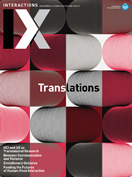Authors:
Caroline Sinders
The city of Amsterdam is using artificial intelligence (AI) to help sort through and triage their version of 311 calls. Chicago is using AI to help analyze, decrease, and prevent rat infestations. There is value in applying AI to urban challenges, but that value must come with explicit protections to privacy and citizen safety. AI has known issues with bias—including a widely documented inability to recognize different genders and races, and its use in predictive policing. Thus, when using AI as infrastructure or in technology that interacts with society, safeguards must be put into place to mitigate harm. When,…
You must be a member of SIGCHI, a subscriber to ACM's Digital Library, or an interactions subscriber to read the full text of this article.
GET ACCESS
Join ACM SIGCHIIn addition to all of the professional benefits of being a SIGCHI member, members get full access to interactions online content and receive the print version of the magazine bimonthly.
Subscribe to the ACM Digital Library
Get access to all interactions content online and the entire archive of ACM publications dating back to 1954. (Please check with your institution to see if it already has a subscription.)
Subscribe to interactions
Get full access to interactions online content and receive the print version of the magazine bimonthly.






